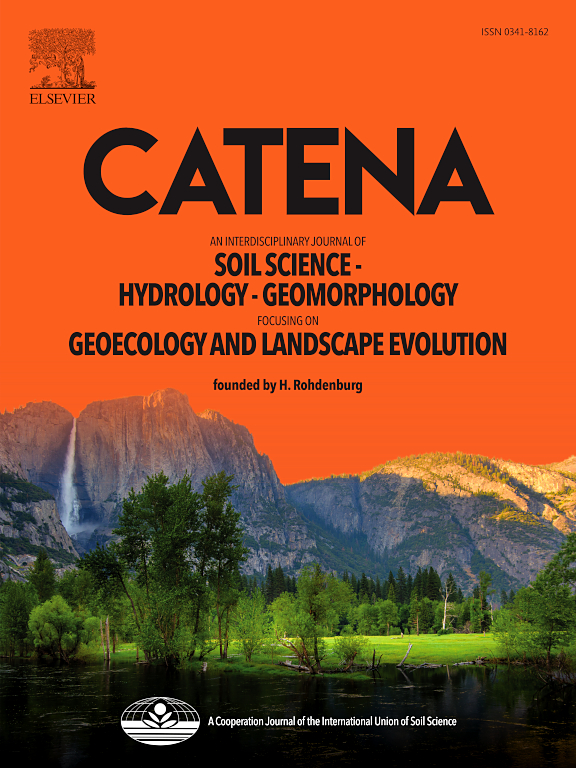Projected increase in soil erosion risk in the karst landscape of the Pearl River Basin under high carbon emission scenarios
IF 5.4
1区 农林科学
Q1 GEOSCIENCES, MULTIDISCIPLINARY
引用次数: 0
Abstract
Soil erosion (SE) risk in watersheds is highly uncertain under the coupled effects of climate change and land use change (LUC). Accurate assessment of SE risk dynamics under future environmental conditions is essential for effective ecological protection and sustainable watershed management. This study highlights the critical role of SSP-RCP scenario input on model predictions and emphasizes the need for consistent integration of climate, natural, and socio-economic factors. We present an innovative integrated downscaling model framework that improves upon traditional downscaling approaches by linking large-scale watershed land use and climate change. In addition, we have optimized the Revised Universal Soil Loss Equation (RUSLE) model by incorporating the rock outcrop factor and integrated key socio-economic drivers to achieve precise assessment of SE risk. Our results show a consistent increase in SE risk under all three SSP-RCP scenarios, with high-risk areas predominantly located in the karst regions of the upper Xi Jiang River Basin. Applying GeoDetector and Geographically and Temporally Weighted Regression models further indicates that subsurface characteristics, natural factors, and anthropogenic activities are the primary drivers of SE risk. Specifically, economic growth and in LUC (cropland and grassland) are the key factors driving the escalation of erosion risk in the upper watershed. Our study presents a novel large-scale watershed downscaling model and an optimized RUSLE framework, enabling an accurate spatiotemporal assessment of SE risk under climate and LUC in the Karst Landscape of the Pearl River Basin. These results provide valuable insights for targeted soil erosion prevention and management in other karst regions.

高碳排放情景下珠江流域喀斯特景观土壤侵蚀风险增加预测
在气候变化和土地利用变化耦合作用下,流域土壤侵蚀风险具有高度不确定性。准确评估未来环境条件下SE风险动态是有效保护生态环境和流域可持续管理的基础。本研究强调了SSP-RCP情景输入对模式预测的关键作用,并强调了持续整合气候、自然和社会经济因素的必要性。我们提出了一个创新的综合降尺度模型框架,通过将大规模流域土地利用与气候变化联系起来,改进了传统的降尺度方法。此外,我们还对修正通用土壤流失方程(RUSLE)模型进行了优化,通过纳入岩石露头因素和综合关键社会经济驱动因素,实现了土壤流失风险的精确评估。结果表明,三种情景下东南风风险均呈上升趋势,高风险区域主要位于西江上游岩溶地区。利用GeoDetector和地理与时间加权回归模型进一步表明,地下特征、自然因素和人为活动是SE风险的主要驱动因素。具体而言,经济增长和LUC(耕地和草地)是驱动上游流域侵蚀风险升级的关键因素。本文提出了一种新的大尺度流域降尺度模型和优化的RUSLE框架,实现了气候和土地利用变化下珠江流域喀斯特景观东南风风险的准确时空评估。这些结果为其他喀斯特地区的土壤侵蚀防治提供了有价值的见解。
本文章由计算机程序翻译,如有差异,请以英文原文为准。
求助全文
约1分钟内获得全文
求助全文
来源期刊

Catena
环境科学-地球科学综合
CiteScore
10.50
自引率
9.70%
发文量
816
审稿时长
54 days
期刊介绍:
Catena publishes papers describing original field and laboratory investigations and reviews on geoecology and landscape evolution with emphasis on interdisciplinary aspects of soil science, hydrology and geomorphology. It aims to disseminate new knowledge and foster better understanding of the physical environment, of evolutionary sequences that have resulted in past and current landscapes, and of the natural processes that are likely to determine the fate of our terrestrial environment.
Papers within any one of the above topics are welcome provided they are of sufficiently wide interest and relevance.
 求助内容:
求助内容: 应助结果提醒方式:
应助结果提醒方式:


